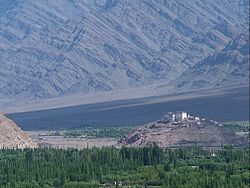
Matho Monastery
Encyclopedia

Buddhism
Buddhism is a religion and philosophy encompassing a variety of traditions, beliefs and practices, largely based on teachings attributed to Siddhartha Gautama, commonly known as the Buddha . The Buddha lived and taught in the northeastern Indian subcontinent some time between the 6th and 4th...
monastery located 26 kilometres southeast of Leh in Ladakh
Ladakh
Ladakh is a region of Jammu and Kashmir, the northernmost state of the Republic of India. It lies between the Kunlun mountain range in the north and the main Great Himalayas to the south, inhabited by people of Indo-Aryan and Tibetan descent...
, northern India
India
India , officially the Republic of India , is a country in South Asia. It is the seventh-largest country by geographical area, the second-most populous country with over 1.2 billion people, and the most populous democracy in the world...
. The village of Matho is located at the mouth of a deep gorge running out of the Zanskar Range and across the Indus. It is directly opposite Thikse
Thikse
Thikse Gompa or Thikse Monastery is a Tibetan Buddhist monastery of the Yellow Hat sect, located on top of a hill, approximately 19 kilometres east of Leh in Ladakh, India...
Monastery.
History
Founded in the 16th century by Lama Dugpa Dorje, it belongs to the SakyaSakya
The Sakya school is one of four major schools of Tibetan Buddhism, the others being the Nyingma, Kagyu, and Gelug...
Order. It is noted for its four hundred year old thangka
Thangka
A "Thangka," also known as "Tangka", "Thanka" or "Tanka" is a Tibetan silk painting with embroidery, usually depicting a Buddhist deity, famous scene, or mandala of some sort. The thankga is not a flat creation like an oil painting or acrylic painting...
s and its Matho Nagrang Festival.
The gompa is the only one in Ladakh belonging to the Sakyapa and is said to be one of the few which is seeing an increase of monks in recent years.
(This picture is not Matho Gompa.)

